Menu
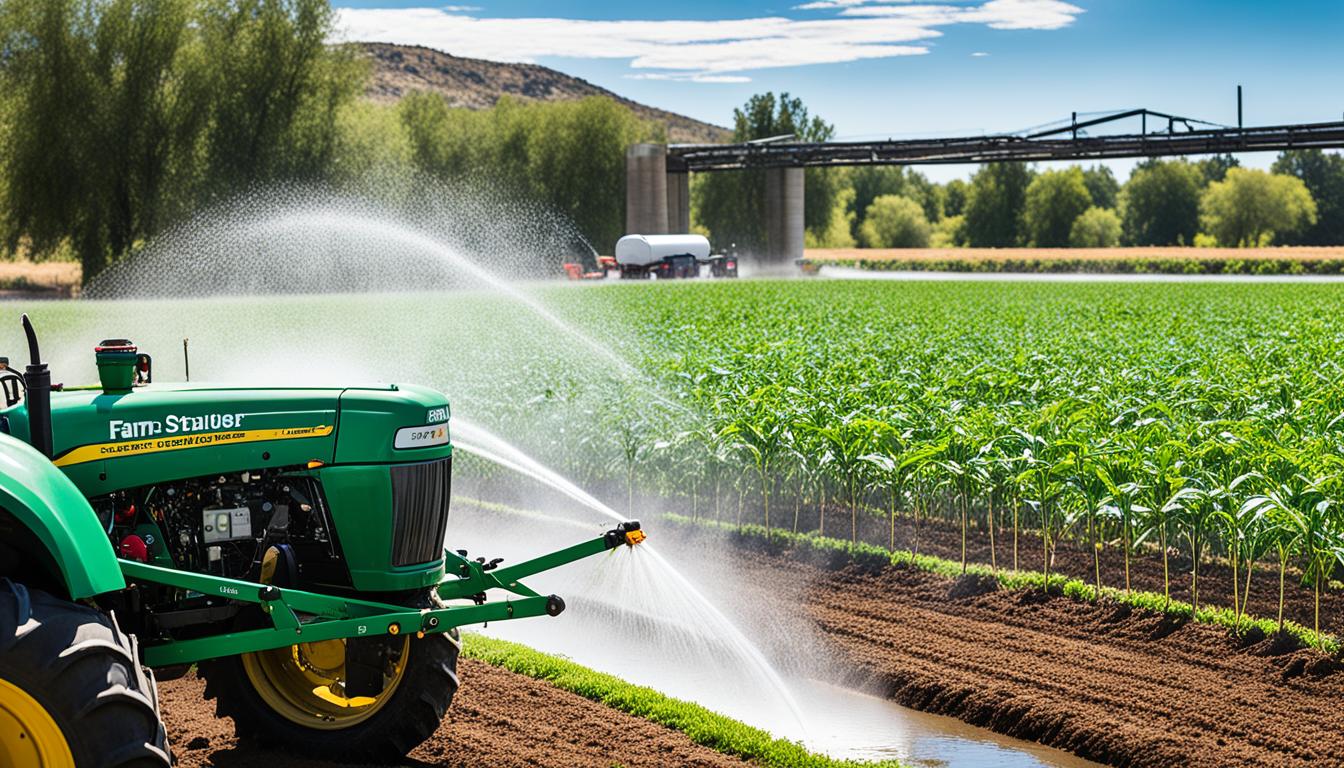
A commercial farm needs to cover at least five acres and make over $2,500 yearly from agriculture. This shows how key commercial farms are and why following water laws matters.
Water scarcity is a big problem now, affecting farming and the environment. It’s crucial for farms to follow environmental compliance guidelines. Using sustainable farming methods can help save water for the next generations. Farmers who understand and follow these laws help both their farms and nature.
There are many rules farming businesses must follow to use water well. These rules make good water management very important. Farmers need to know the best ways to use water. This helps them stay legal and also protect the environment.
Protecting our water resources is vital to the future of our planet. Laws that focus on saving water in farming help keep our natural resources safe. They also make sure there is enough water for farming in the years to come.
These rules are about using water wisely on farms. They teach farmers how to use less water but still grow their crops. This is good for the earth and for the farmers too.
Water is getting scarce, and we need to act fast. By following water conservation laws, farmers can save water. This keeps their farms running well and helps the planet too.
These rules also help farms stay productive and make money. So, it’s a win-win for everyone.
In farming, saving water is a big deal. The Farm Bill has programs that encourage farmers to use water more wisely. Regulations like Senate Bill 555 make sure companies that sell water to cities lose as little water as possible.
Farms must also test their water to make sure it’s safe. If the water isn’t right, they have to fix it. This can mean adding chemicals to make the water clean.
Water-saving rules have changed how farms work. Now, farmers check their water systems more often. This helps catch problems early, before they can affect the crops.
Farmers must also be careful about the water they use. They test it regularly to make sure it’s clean. This keeps their farms and the water safe for everyone.
Following these laws is good for the environment and for the farms. When farmers save water, they’re helping the planet and making sure their farms will thrive for a long time.
Following water conservation laws is key for farms to last. It means using water wisely to protect nature. We’ll look into what rules farms must follow, and what happens if they don’t.
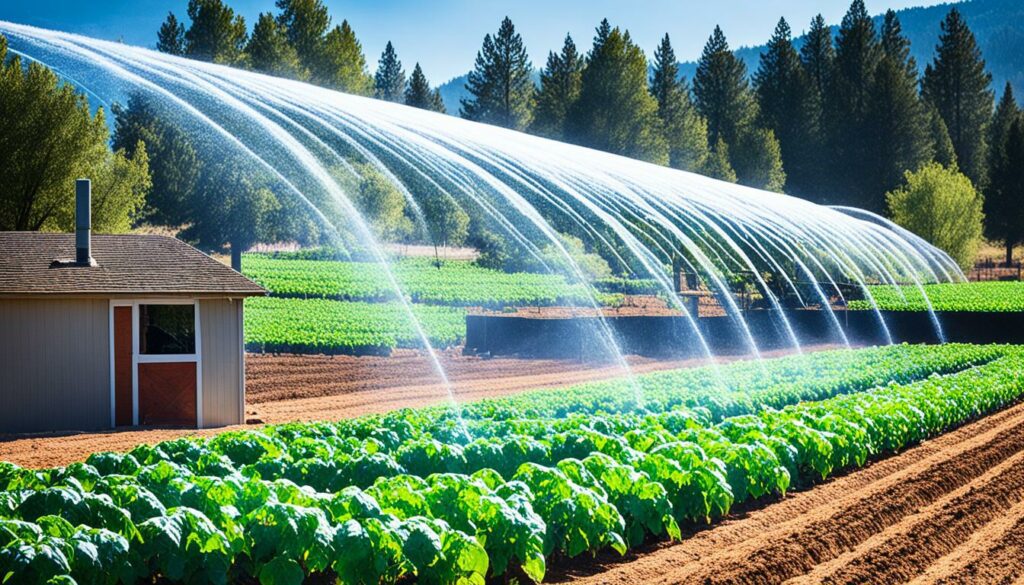
Farms need to meet many laws to stay compliant. This includes keeping water safe and testing it for germs. They have to make sure water for crops is very clean.
To be legal, farms need permits from water agencies. They must check their water often to stop it getting dirty. If a farm uses river water, they test it regularly to make sure it’s safe for plants.
Not following the rules can bring big trouble. Farms might not get help from the government or insurance. Being careful with water and following all rules is crucial to avoid these problems.
| Requirement | Details |
|---|---|
| Water Quality | Must meet FDA standards, specifically for generic E. coli |
| System Inspections | Regular inspections required to prevent contamination |
| Permits | Necessary approvals from Water Management Districts |
| Recordkeeping | Comprehensive records of water testing and treatments |
To keep farms productive and the environment healthy, efficient water usage is vital. It’s key to manage irrigation well, use cutting-edge water-saving tech in farming, and always check and keep things up. This is how we can save water and keep everything running smoothly.
Great irrigation management helps farms use water better. It involves smart scheduling of water for crops and using tech like LESA and subsurface drip irrigation. These reduce water lost to the air. Plans by the Texas Water Development Board suggest that farms use water in different ways. This shows the importance of adjusting our plans for each area.
Turning to water-saving technologies in farming can really change how efficiently we use water. Features like variable rate irrigation and wireless sensors make sure water goes exactly where crops need it, cutting waste. Thanks to SWIFT projects from 2015 to 2016, a lot of water was saved with these new methods.
Keeping an eye on and fixing up irrigation systems regularly is a must. This keeps water usage efficient over time. In Texas, rules from groundwater conservation districts aim to save water underground. Following the best tips for using water well helps farming last longer and saves water for the future.
| Year | Projects Funded | Water Saved (acre-feet) |
|---|---|---|
| 2014 | Conservation Education Grants | Data Provided |
| 2015 | Conservation and SWIFT Projects | Significant Savings |
| 2021 | Water Supply Enhancement Program | Projects Totaled |
Understanding water usage rules is key for farmers. The Food Security Act of 1985 is vital. It says farmers must protect wetlands to get USDA help. They must not farm on wetlands or turn them into farmland.
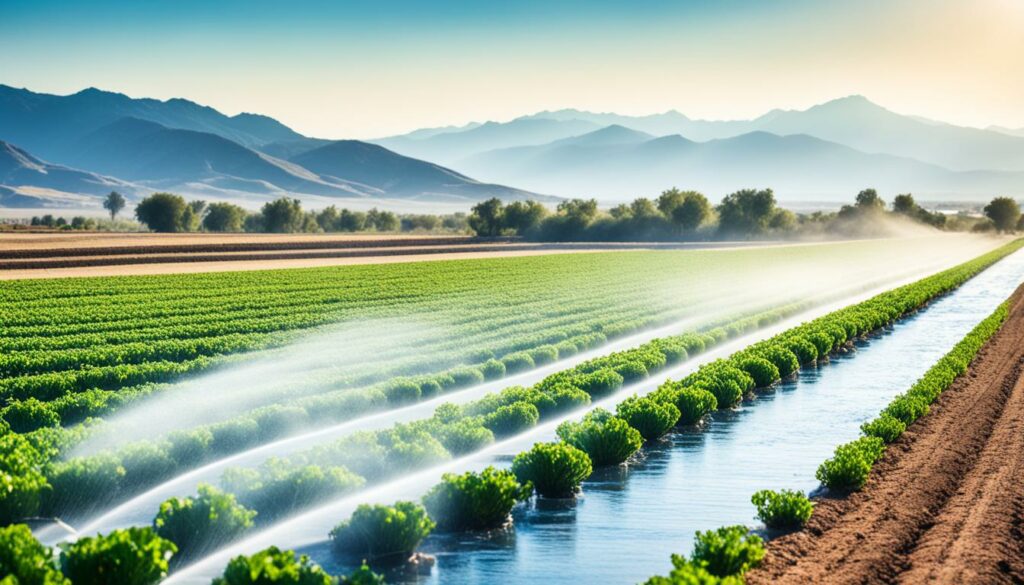
Farmers must fill out Form AD-1026 to follow these rules. This applies to all their land, not just some parts. The NRCS checks if there are wetlands or erodible soils on the farm. If there is a problem, farmers can ask for a review.
Land with easy-to-erode soil needs special care. Farmers must follow a plan approved by the NRCS for such land. They should not farm on wetlands. Producers also shouldn’t turn wetlands into farmland by removing trees or water.
A new rule is changing how we look at water in farming. This rule wants to check water quality in a different way for almost all crops. The aim is to check water better to make food safer and prevent illnesses.
These changes are because of the FDA Food Safety Modernization Act. The goal is to make sure the fruits and vegetables we eat are always safe. People can share their views on these changes up to April 5, 2022.
| Regulation Aspect | Details |
|---|---|
| Compliance Certification | Producers file Form AD-1026 to certify compliance with wetland conservation. |
| Highly Erodible Land | Designation and management are based on NRCS-approved conservation plans. |
| Wetland Conservation | Prohibition on converting and farming on wetlands for agricultural purposes. |
| Proposed Rule Revisions | Shift to systems-based water assessments for pre-harvest water management. |
| Public Comment Deadline | Comments on the proposed rule must be submitted by April 5, 2022. |
Water Management Districts (WMDs) are key in supervising water use. They ensure water is used sustainably, especially in farming. WMDs have many important tasks to make sure water is managed well.
WMDs work mainly on managing water use and permits. They decide how much water can be taken from nature. It’s their job to stop too much water from being used.
Farmers must get a permit to use water right. They also need to prove they’re using water wisely. This helps keep water clean and ready for the future.
WMDs also watch over the building and care of well construction and maintenance regulations. They make sure new wells and old ones are safe and don’t harm the water below. Following these rules involves using the right building methods, keeping wells at the right depth, and regular checks.
It’s very important for farmers to keep their wells in good shape. This affects how well their crops grow. If they don’t look after their wells as they should, they might not be allowed to keep using them.
| Responsibilities | Actions Required |
|---|---|
| Water Allocation | Obtain necessary permits, demonstrate conservation practices |
| Well Construction | Adhere to sealing techniques, maintain specified depths |
| Well Maintenance | Conduct routine inspections, ensure ongoing maintenance |
WMDs make sure everyone uses water fairly. They check that rules about building and caring for wells are followed. This helps manage water well and keep it safe for the future.
Using sustainable farming methods helps to save water in agriculture. Cover crops and no-till farming are key. They save water and keep the soil healthy.
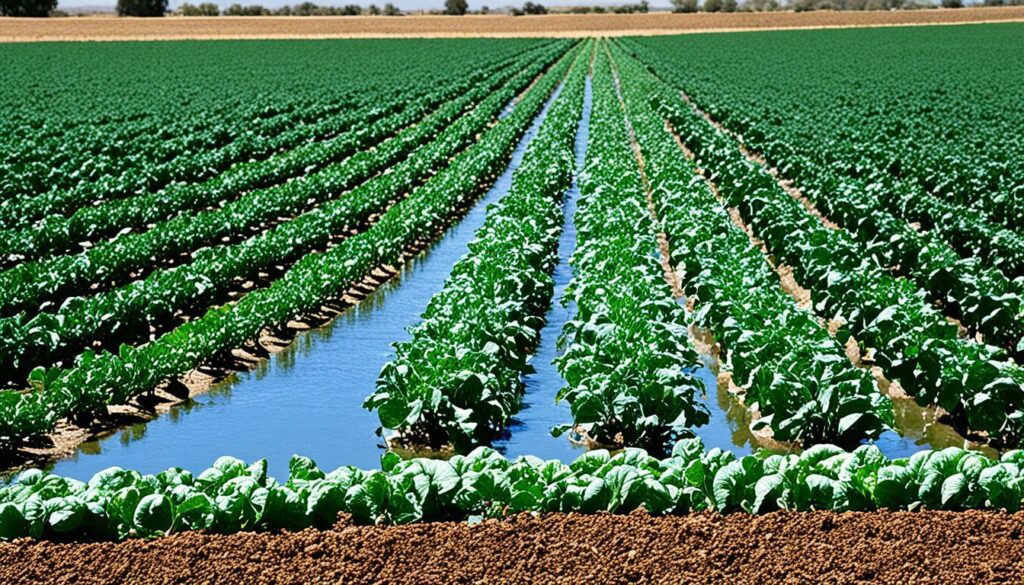
Cover crops stop soil from washing away. They also keep the soil damp. This lessens the need for lots of watering. No-till farming protects the soil, helps keep it moist, and is good for the environment.
Managing nutrients well is vital in farming. It stops nutrient runoff and leaching. This keeps water in the soil where plants need it. Smart irrigation and drip systems reduce water loss, helping to save water.
| Technique | Benefits |
|---|---|
| Cover Crops | Reduce soil erosion, retain moisture, enhance soil health. |
| No-Till Farming | Minimize soil disturbance, improve moisture retention, reduce erosion. |
| Smart Irrigation Systems | Reduce water wastage with precise watering schedules. |
| Drip Irrigation | Deliver water directly to plants, minimize evaporation and runoff. |
Sustainable farming laws aim to balance farm growth with looking after the land. Many new laws now help farms use more natural methods. This includes saving water and other eco-friendly actions.
The Conservation Reserve Program is a key law. It turns over 5 million acres of land a year into habitats like grasslands or wetlands. This helps with the health of our environment and the species in it.
The Inflation Reduction Act gave nearly $40 billion to farming and rural areas. Half of this was for programmes that help save nature. For instance, Decatur, IL, got $9 million to make the water cleaner in 2022. This shows how big investments can help the planet.
A new idea is to support farmers with insurance if they use eco-friendly methods. This could encourage more farmers to treat the land better.
The Farm Bill’s renewal is also vital. Leading groups have shared what they think with the Senate and the House. It needs to be sorted by September 30 to avoid major issues for farming and towns.
The Food Safety Modernization Act helps too. It sets tough rules for using water in farming. These rules aim to keep our food safe and the land clean.
Using these rules may mean treating water or checking it often. This is to make sure it’s safe for farming. It fits in with the goal of helping the Earth and keeping people healthy.
Through these laws, we are making a plan to farm in a better way. This helps keep our natural resources safe for the future. Working together, we can farm without harming the environment.
| Legislative Measure | Key Focus | Investment/Impact |
|---|---|---|
| Conservation Reserve Program | Land conversion to grasslands, forests, wetlands | 5 million acres enrolled in 2023 |
| Inflation Reduction Act | Agriculture & rural development | $40 billion allocated, $20 billion to USDA conservation programs |
| Farm Bill Reauthorization | Economic & environmental support | Impact on local communities and economies |
| FSMA Agricultural Water Standards | Water safety regulations | Minimise produce contamination by pathogens |
Water conservation in farming is crucial. Implementing the best practices helps farms use water well. They must also meet the water use rules by agencies like the FDA. The FDA’s Produce Rule improves farm water use for safer produce under the FSMA.
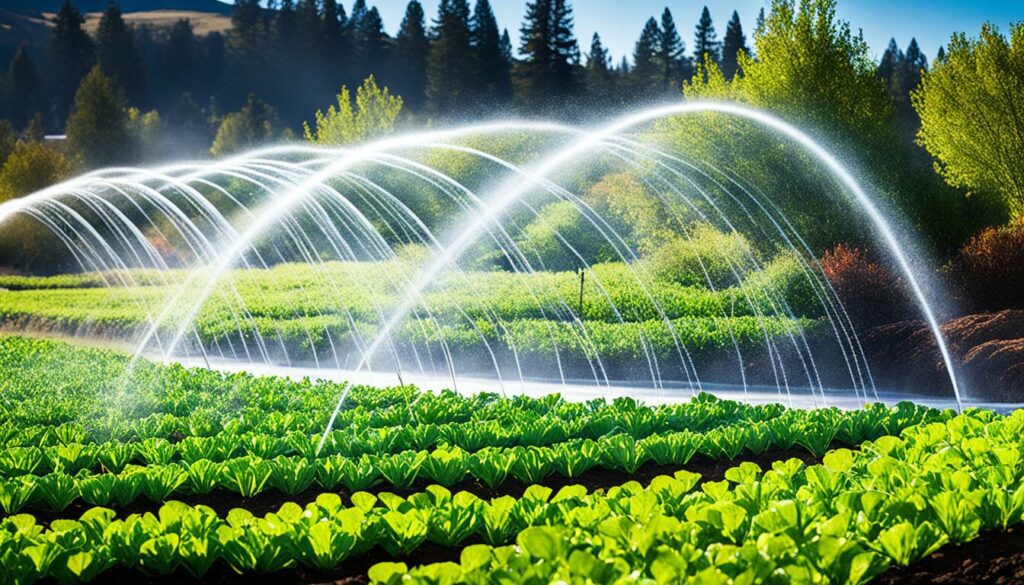
Creating a strong water saving plan is key. It should meet the FDA’s tough water rules. This includes quality checks, treating water, and keeping records. If water might touch crops or be used in food prep, it must have no E. coli. Testing for this is vital.
Training and teaching workers is vital for a good water plan. Workers should know why managing water well is important. They should be familiar with testing for direct contact and the FDA’s strategy for using natural water. This strategy involves surveys, yearly tests, and setting new benchmarks. Workers who are skilled in this help in effective water saving. This protects the environment and the food’s quality.
| Statistics | Details |
|---|---|
| Chesapeake Bay Watershed | 83,000 farms; $10 billion annual agri-production value |
| NRCS Conservation Practices | 1.26 million acres facilitated (2018-2020) |
| USDA Investments | $22.5 million in FY 2022; $1.1 billion over the past decade |
| NWQI Impact | Over 5,600 producers, 1.19 million acres (since 2012) |
In recent years, many water conservation projects have shown us how to save water in farming. Take the Portland Water District, for instance. It grew its preserved land from 1605 acres to 4180 acres from 2012 to 2017. This shows their strong commitment to saving water in farming.
The Sebago Clean Waters partnership is another shining example. They won an $8 million grant in September 2020. Before that, they got $350,000 from the Healthy Watersheds Consortium from 2017 to 2020. These grants have helped fund important water-saving projects.
Then, there’s the WISPr program in Vermont. It helps by cutting water projects’ costs. This makes it easier to join traditional water treatment with new conservation efforts. It’s like getting a discount on saving water.
The 2021 New England Conservation Finance Roundtable data also is telling. It shows a big interest in working together to save water. Lots of people are already starting or want to start conserving water. The way we fund water-saving projects is changing for the better.
| Initiative | Details |
|---|---|
| Portland Water District | Increased conserved acreage from 1605 in 2012 to 4180 in 2017 |
| Sebago Clean Waters Partnership | Received $8 million in grants, contributing to multiple conservation projects |
| WISPr Program | Reduces annual loan payments via administrative fee adjustments |
| New England Conservation Finance Roundtable | 36% unsure about water utility partnerships, 39% actively engaging, and 26% eager to try |
These stories show the power of working together and finding smart ways to pay for saving water. By learning from these examples, farmers and leaders can discover new ways to save water in farming. This is key for our agricultural future.
Water conservation laws are key to ensuring farm practices last and the land is used wisely. In Texas, which has lots of farming, using water wisely is very important. This is because the state relies on water from the ground and from rivers, which is controlled by many groups. Since farming uses the most water in Texas, it’s critical for farmers to follow these laws. This helps protect water but also helps keep farming productive.
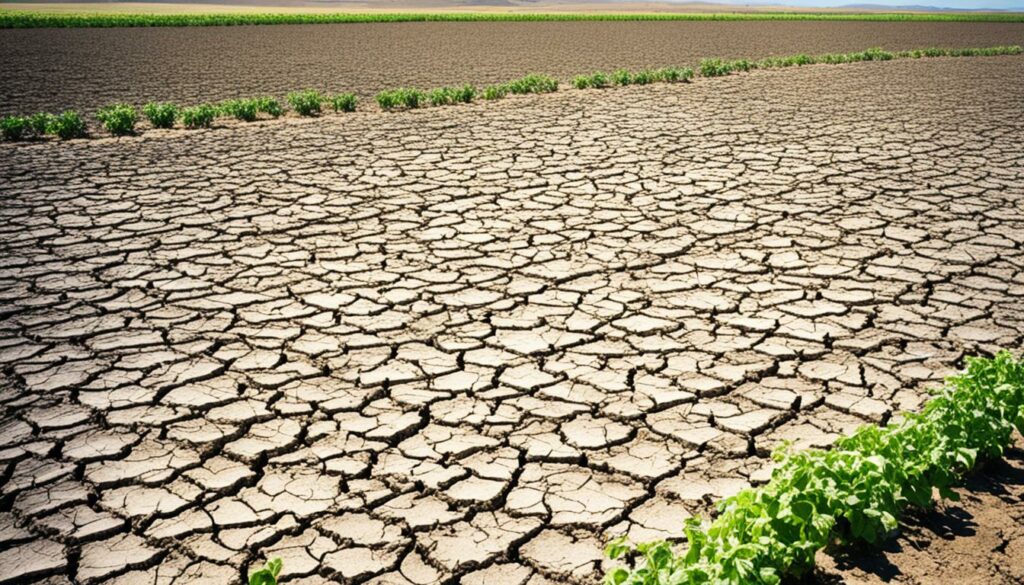
New tech in watering crops, like LESA and drip irrigation, has made a big improvement. It cuts down on water lost to air and uses water better. This technology helps farmers follow water laws and be careful with water use.
But, dealing with water rights with Mexico makes things more complicated. This is because there’s not a clear plan for sharing water from the ground. Not having strong rules can make it hard to save water and protect it. With demand for water going up in Texas, following these laws is crucial for the future.
In the Texas Panhandle, using groundwater smartly is especially important for farming. By using water-saving methods, farms become more sustainable and can grow better crops. Following these water-saving laws can help farms do even better, providing more food and better quality produce.
Important plans are made for how to use groundwater wisely and fairly. These plans make sure water is available for a long time. They are key for making sure farms have enough water and can grow well. While some insurance helps with natural disasters, it doesn’t help if water isn’t managed well. This shows why it’s so important to stick to the water-saving laws.
To wrap up, water laws do more than just save water. They also help farms be efficient and grow food well. By doing so, they help protect the future of farming in places like Texas. For more on Texas water laws and farming, check this out.
Farmers looking for help to understand water conservation laws have lots of resources. They include both government and non-governmental support. The aim is to help farmers use practices that are good for the environment.
Government-run schemes give farmers big help with sustainable farming. For example, the CRP pays farmers yearly to not use certain lands. The CREP pays for conservation actions on their farms.
ECP and EFRP also give help after natural disasters hit farmlands and forests. FWP supports farmers in restoring wetlands, and GRP helps protect land from being turned into cities. These programmes help keep farms and forests healthy.
SWPP focuses on some places to keep the water safe to drink. The Chesapeake Bay area sees a lot of support to protect its water and farms. From 2018 to 2020, NRCS helped with over a million acres of land. They plan to give more support, showing a strong commitment.
NGOs are also key in helping farmers with sustainable farming. Since 2012, NRCS has worked with many to improve over a million acres of land. They have made 16 water bodies cleaner thanks to this work.
They have used many effective methods, including cover crops and smarter use of nutrients. Efforts around the Great Lakes have significantly reduced phosphorus since 2010. This proves these methods work.
NRCS’s edge-of-field monitoring helps farmers see the direct effect of their actions. This way, farmers can make smart choices that are good for the environment. With new water quality standards, farmers have more control over their produce’s safety.
| Program | Benefit for Farmers | Focus Area |
|---|---|---|
| CRP | Annual rental payments | Environmentally sensitive land |
| CREP | Rental payments for high-priority conservation measures | Conservation-focused land use |
| ECP | Funding and technical assistance | Restoration post natural disasters |
| EFRP | Funding for forest restoration | Privately owned forests |
| FWP | Annual rental payments | Restoration of wetlands |
| GRP | Rental payments for voluntary limiting land development | Rambling and pasture land |
| SWPP | Water protection | Drinking water sources |
Both the government and NGOs play vital roles in promoting sustainable farming. They help farmers with legalities and support long-term environmental care.
Keeping farms compliant with water laws is key for them to run sustainably. It involves many steps, including regular audits and being up-to-date with the laws. Let’s explore these important points for farms to follow the rules well.
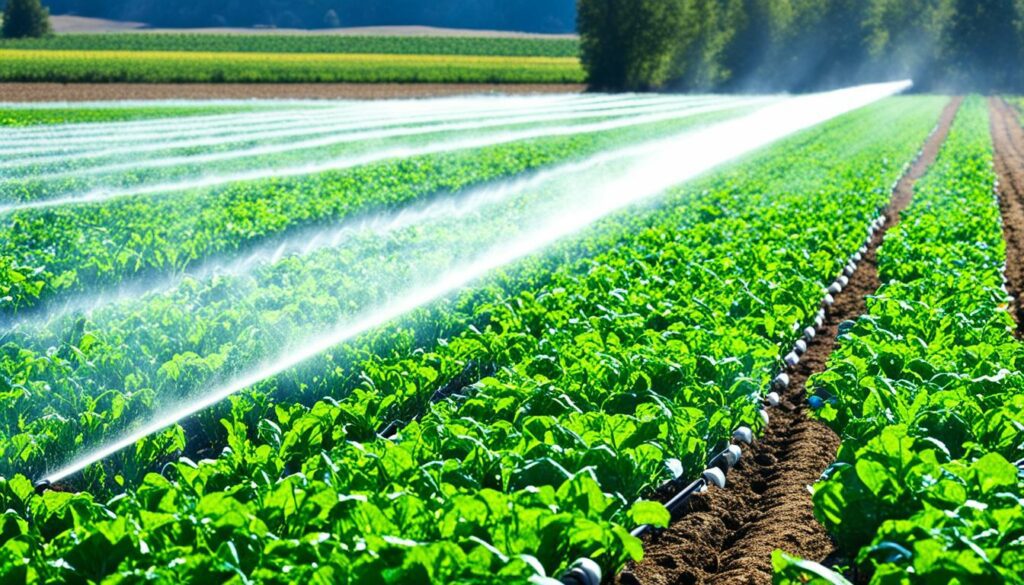
Doing regular checks on compliance is vital. This lets farms spot where they need to do better. It also helps them keep up with the latest rules. Since 1985, when the conservation program started, the focus on these checks has grown. They help solve problems early, stopping them from growing big.
Knowing the latest in conservation laws is crucial for farms to stay legal. Rules can change fast, so it’s important to pay attention to both federal and state laws. A case like USDA v. Boucher shows how laws are always evolving. This proves we must keep learning to avoid trouble.
In September 2019, the American Farm Bureau called for more fairness in following rules. They asked for changes like training judges and giving better documents to farmers. This shows why everyone involved needs constant updates. It ensures everyone knows what they should do.
In the end, things like regular audits and keeping up with laws are not just for following the rules. They also help create a culture where farms care about the environment and being responsible.
In wrapping up our deep look into how farms follow water rules, let’s think about what we’ve learned. We checked out 4,216 farms in pilot areas like Brunswick and Columbus, among others. From this, we now know that the rain’s uneven spread in 2010 really affected how well farms followed the rules.
Changing weather and its impact on following rules are loud and clear. Seven farms hit hard by these issues and 18 more felt the pinch. Out of 166 farms, they really show why keeping up with best ways to use water is essential. Besides, finding big problems on a few farms during checks proves we must never stop getting better.
Looking at costs, the Department of Soil and Water Conservation (DSWC)’s checks cost less on pilot farms than others. This is mostly because they check these farms more often. Now, all 166 pilot farms are moving towards better, eco-friendly practices. This change shows the huge role water-saving plays, not just in keeping laws but in helping farms be greener and saving our environment.
To wrap up, what we’ve seen tells us that farms need to keep getting better at saving water. Using smart ways and new tech can help farms stay successful and do less harm to our planet. Following water rules well doesn’t just help our environment. It also makes sure farms are ready for less water in the future.
In agriculture, saving water is key to using our resources wisely. It keeps our surroundings healthy and farms running for the long haul.
Water laws focus on how much water can be taken and used. They set standards to keep our water safe and available for the future.
They require farmers to be smart about water use. This means using water carefully and picking crops that don’t need as much.
Farmers have to get permits and follow certain rules. They must limit their water use, keep records, and use water wisely to protect the environment.
If a farm doesn’t follow the rules, they could get fined. They might also lose their water rights or have to stop farming until they fix it.
Top tips include using the latest irrigation, planting crops that don’t need much water, using water-saving tech, and checking water systems often.
These districts manage water use and make sure farms use water wisely. They check if farms fit within the rules to protect our water.
For wells, farms must get permits and keep them up to scratch. They must be safe for water and not harm the environment.
Ideas like planting cover crops, farming without tilling, and managing nutrients well, cut how much water farms need. They also keep water in the soil and stop it running off.
Laws offer money, help, and advice to farmers who use practices that save water and look after nature. These laws encourage eco-friendly farming.
Good planning involves looking at water use closely and setting goals to save water. Farms should choose the best tools and teach their teams to save water.
Definitely. For example, projects in the Chesapeake Bay area have shown that working together and using smart tools can make a big difference in saving water.
Although they might seem tough at first, following these laws often makes farms more productive. By being careful with water, costs go down, and farm management gets better.
Farmers can get help from the government, NGOs, and farming associations. These groups offer money, training, and advice to help farms follow the laws and be sustainable.
Farms should check if they’re sticking to the rules, and keep learning about new laws. They should also use tools that save water and make caring for the environment a part of their everyday work.